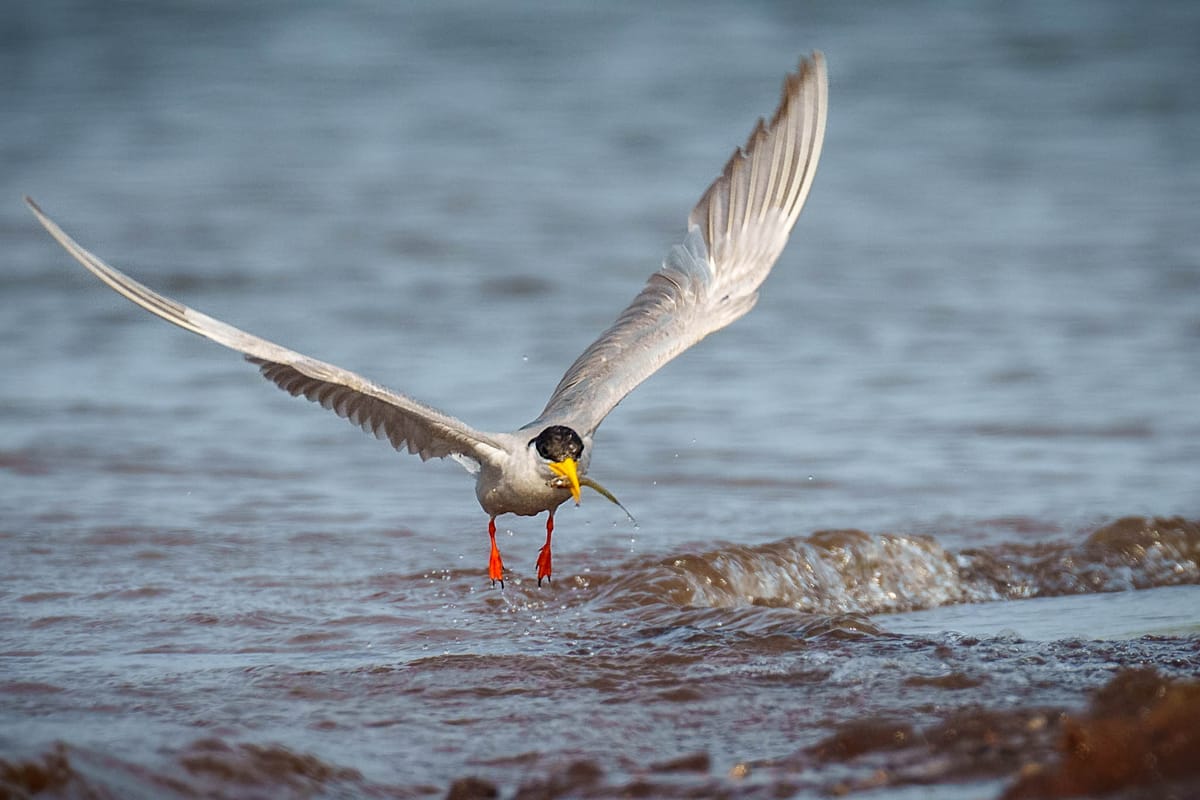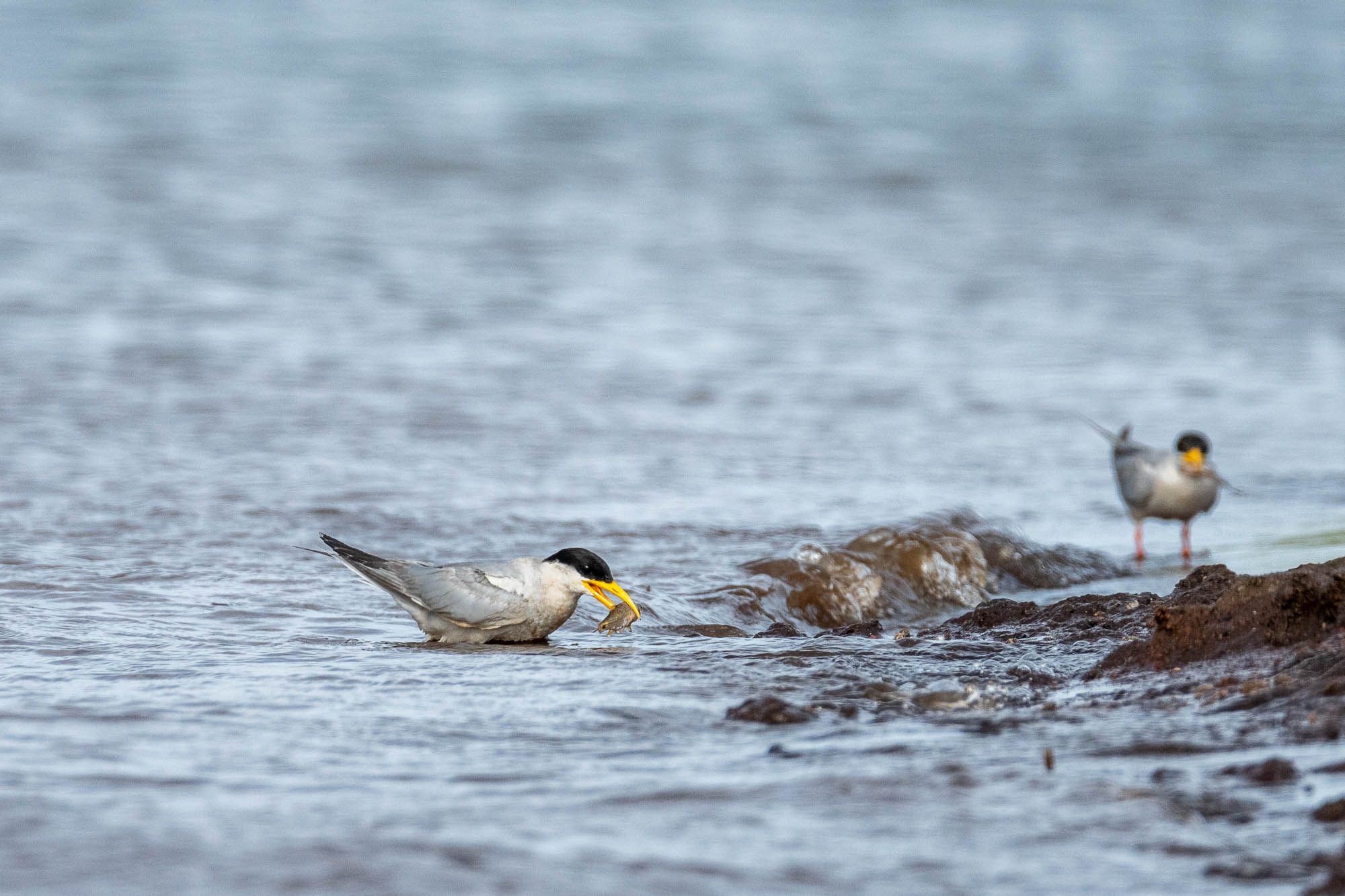The River Terns at the Bhadra
The terns are in the hundreds, thousands, flitting around, absorbed in what they're wired for, paying no attention to you or your boat.

A Brahminy-kite is soaring over the waters, staring straight down. Down below, a tall black pole juts out of the water, and on its top perches a cormorant, gazing horizontally toward far hills on my right. On my balcony on a steep slope, I'm at eye level with the kite. In the distance, where water meets land, a broad swathe of grassy plain runs between the shore and green forest. The forest rises up on low hills from the verge of the plain.
Sometimes, elephants and sloth bears emerge from the forest onto the plain. With binoculars, you can watch them.
A half-dozen river terns fly about below the kite and over the cormorant. They are grey on top, but their whites catch the sun and shine, so I can pick them out from the vast spectacle of hills, waters, and forests. Their calls, coming up over the sounds of wind and water, are sharp and constant.
The terns have strayed in small numbers into this cove-like enclosure. Their home is with a colony of hundreds of their kind settled on an island a fifteen-minute boat ride away.
Such is the scene before the cottages at The River Tern Lodge—the sight as it was the afternoon of my arrival at the Bhadra Reservoir, where I'd gone for the terns.
River terns dwell in freshwater habitats from Iran in the west to Thailand in the East. They arrive here in Bhadra in February on an islet among the backwaters of the Bhadra dam—when the water level is low and islets have formed. Pebbles and short grass on the island conceal the terns' eggs and chicks from kites and falcons. Land animals have better options than in this water-locked place.
The favourite fish of the terns is the slender bilchi, four to five inches long. Kaddy-meenu, they call the fish in Kannada. Stick fish.
The government controls all activity in the area, citing conservation concerns. It runs the sole tourist lodge for visitors, The River Tern Lodge.
Government boats take you to the island of the terns. As we approached, I'd tuned out the motorboat's racket; but a new, rising din assailed me: the kyeerk-kyeerk of hundreds of terns. I've experienced bats before, but the numbers here surprised me. The terns were in the hundreds, thousands maybe—grey and white, red in the legs and yellow-beaked, a foot and a half long and flitting around, absorbed in what they're wired for, paying no attention to us or our boat.
On land, tiny, severely tousled chicks waited in the open to be fed. In several places, dead, decomposing birds with loosed feathers lay right by the chicks. Grown birds flew over them, going out and coming in with thin silvery fish in their beaks.
It was all fast-paced action, ceaseless motion accompanied by insistent bird cries.
I'd checked and rechecked the settings on my camera, the Sony Alpha-1, reputed for its tracking ability. In frisson, unable to calm myself in that charged atmosphere and faced with too much of a good thing, it was a struggle to compose the shot. And there was also the boat, bobbing beneath me.
I'd brought a 200-600mm telephoto lens on my camera; I wished for a wider lens that could take the whole scene.
What happens is that mostly the males fly out, pick bilchi (barilius) fish off the water, bring the catch to the shore and wash it—to get them clean and moist for swallowing. Other males try to grab the fish, and they must be warded off. Then, the males take the fish to the female of their fancy and, with seductive hops, offer the gift of the fish. Even in these moments, the fight with competing males continues. Should the female accept the present, there's the final task to get the bilchi to her beak. That accomplished, the males have performed a harrowing feat, demonstrated great courage and gallantry, and won love.
My visit to the river tern island was in early June, on the eve of the monsoons, which were in delay. Once the rains take hold, rising waters submerge the islets, and the terns must fly ahead of the event to safer wetlands supplied by freshwater. I remember now the numerous chicks on the island that were still fed by their parents. Those chicks hadn't yet learnt to fly. Meanwhile, males still carried gift fish to females, meaning more eggs and chicks were coming. The rains had hit Kerala and were coming north; Bhadra was a mere week away. Inundation was imminent.
